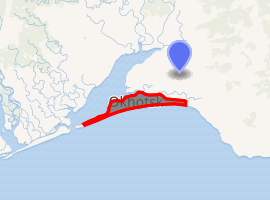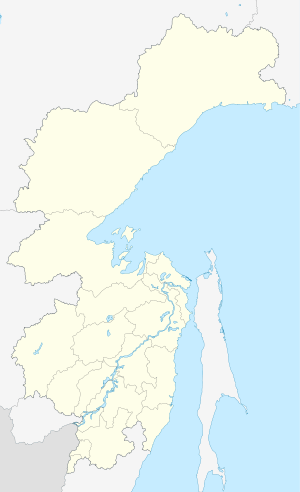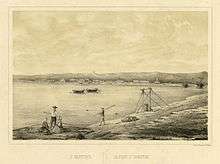Okhotsk
Okhotsk (Russian: Охотск, IPA: [ɐˈxotsk]) is an urban locality (a work settlement) and the administrative center of Okhotsky District of Khabarovsk Krai, Russia, located at the mouth of the Okhota River on the Sea of Okhotsk. Population: 4,215 (2010 Census);[1] 5,738 (2002 Census);[4] 9,298 (1989 Census).[5]
Okhotsk Охотск | |
|---|---|
Work settlement | |
_(1790).png) Coat of arms | |
Location of Okhotsk 
| |
 Okhotsk Location of Okhotsk  Okhotsk Okhotsk (Khabarovsk Krai) | |
| Coordinates: 59°22′03″N 143°15′34″E | |
| Country | Russia |
| Federal subject | Khabarovsk Krai |
| Administrative district | Okhotsky District |
| Founded | 1647 |
| Urban-type settlement status since | 1949 |
| Population | |
| • Total | 4,215 |
| • Capital of | Okhotsky District |
| Time zone | UTC+10 (MSK+7 |
| Postal code(s)[3] | 682480 |
| Dialing code(s) | +7 42141 |
| OKTMO ID | 08634151051 |
History
It was the main Russian base on the Pacific coast from about 1650 to 1860, but lost its importance after the Amur Acquisition in 1860. It is located at the east end of the Siberian River Routes on the Sea of Okhotsk where the Okhota and the Kukhtuy Rivers join to form a poor but usable harbor.
.jpg)
In 1639 the Russians first reached the Pacific 105 kilometres (65 mi) southeast at the mouth of the Ulya River. In 1647 Semyon Shelkovnikov built winter quarters at Okhotsk. In 1649 a fort was built (Kosoy Ostrozhok). In 1653 Okhotsk was burned by the local Lamuts. Although the Russian pioneers were skilled builders of river boats, they lacked the knowledge and equipment to build seagoing vessels, which meant that Okhotsk remained a coastal settlement and not a port. In 1682 Okhotsk had eight dwellings and five other buildings. When the Russians entered the Kamchatka Peninsula they had to travel overland from the north.
In 1714, Peter the Great sent a party of ship-builders to Okhotsk to provide faster access to the furs of Kamchatka. In 1715, they built the vessel Vostok and in 1716–17 Kozma Sokolov sailed it to Kamchatka. For the next 145 years Okhotsk was the main Russian seaport on the Pacific, supplying Kamchatka and other coastal settlements. In 1731 the Siberian Military Flotilla was established here. In 1736, Okhotsk was moved 3 km (2 mi) downstream to a spit of land at the mouth of the Okhota River, converting the ostrog into a proper port. Vitus Bering's two Pacific expeditions (1725–1729 and 1733–1742) brought in large numbers of people, including the first scholars and expert sailors, and led to a great deal of building. In 1742 there were fifty-seven already-established buildings, forty-five newer buildings in Bering's "expedition settlement," and eight ships in the harbor. Anton de Vieira was the town's governor at that time; he was of Portuguese origin, son of a Jewish father and Christian mother. From 1737 to 1837 there was a salt works several kilometres west on the coast that produced 14–36 tons of salt annually; in 1827 it was worked by a hundred and fifty exiles and about a hundred guards and overseers.
Bering's men found valuable sea otters east of Kamchatka, and fur hunters began island-hopping along the Aleutian Islands. Furs were brought back to Okhotsk and carried inland, mostly to be sold to the Chinese at Kyakhta. The Russian-American Company was founded in 1799 with its base at Okhotsk, which brought in more money to the town. In 1822 the Scottish traveler Captain John Cochrane ranked Okhotsk just after Barnaul as the neatest, cleanest, and most pleasant town he had seen in Siberia.
From at least 1715 it was clear that Okhotsk was a poor site for a city. In addition to the difficult track inland, (see Okhotsk Coast) the harbor was poor, and the short growing season and lack of plowland meant that food had to be imported. Around 1750 there were only thirty-seven peasant families and a number of Yakut cattlemen living there. There was so little pasture in the area that pack horses sometimes had to be returned to Yakutsk unloaded. The harbor was ice-free from May to November, but the sailing season ran only from June through September. The town was built on a low narrow spit blocking the mouths of the two rivers. The harbor inside the spit was large but shallow; three quarters of it was a mud flat during low water. Large ships could cross the bar only on an incoming or outgoing high tide. Ice-choked water during the spring breakup frequently flooded the town (twenty times from 1723 to 1813), as did high surf on a number of occasions. In 1810 the Okhota River, its mouth jammed by ice, cut a new channel through the spit and isolated the townsite; the town was moved to the spit east of the harbor mouth five years later. Goods now had to be unloaded and barged across the harbor; because the harbor was shallow, Yakuts had to wade with loads from shore to barge. Fresh water had to be fetched from 4 km (2 1⁄2 mi) away. Goods could not be brought down along the Kukhtui River because of swamps.

In 1840 Vasily Zavoyko became head of the Russian-America Company post at Okhotsk and decided to move the post south to Ayan, a move that was completed in 1845. The Yakutsk-Ayan Track was built and then rebuilt in 1852 at a cost of 20,000 rubles, by-passing Okhotsk. In 1849 Siberian governor Nikolay Muravyov-Amursky followed the Russian-America Company's example and decided to move the Siberian Flotilla to Petropavlovsk-Kamchatsky and other government facilities to Ayan. The Amur Acquisition in 1860 continued the shift of Russian focus to the south. From 1870 Okhotsk was supplied from Nikolayevsk-on-Amur. Further loss of importance came in 1867 when Russian America (Alaska) was sold to the United States. The total population decline of Okhotsk went from 1,660 in 1839 to one hundred in 1865.
Between 1849 and 1866, American whaleships cruised for bowhead whales in the waters off Okhotsk.[6][7] Some caught whales within sight of the settlement[8] while others visited the town itself.[6][9] They also fished for salmon in the Okhota River.[6]
Okhotsk was of some military importance during the Russian Civil War, when the White army generals Vasily Rakitin and Anatoly Pepelyayev used it as their place of arms in the Far East.
Okhotsk was also a launch site of sounding rockets between 1981 and 2005. The rockets reached altitudes of up to 1,000 km .
The importance and population of Okhotsk sharply declined following the demise of the Soviet Union.
Transportation
Okhotsk is served by the Okhotsk Airport.
Climate
Okhotsk has a subarctic climate (Köppen climate classification Dwc) with very cold, dry winters and mild, wet summers.
| Climate data for Okhotsk (1981–2010, extremes 1891–present) | |||||||||||||
|---|---|---|---|---|---|---|---|---|---|---|---|---|---|
| Month | Jan | Feb | Mar | Apr | May | Jun | Jul | Aug | Sep | Oct | Nov | Dec | Year |
| Record high °C (°F) | 5.5 (41.9) |
2.0 (35.6) |
6.4 (43.5) |
16.0 (60.8) |
26.2 (79.2) |
31.3 (88.3) |
31.0 (87.8) |
32.1 (89.8) |
24.8 (76.6) |
15.7 (60.3) |
6.2 (43.2) |
2.8 (37.0) |
32.1 (89.8) |
| Average high °C (°F) | −17.8 (0.0) |
−14.3 (6.3) |
−7 (19) |
0.0 (32.0) |
5.7 (42.3) |
11.1 (52.0) |
15.6 (60.1) |
17.0 (62.6) |
12.7 (54.9) |
2.2 (36.0) |
−10.2 (13.6) |
−17.2 (1.0) |
−0.2 (31.6) |
| Daily mean °C (°F) | −20.7 (−5.3) |
−18.5 (−1.3) |
−12.8 (9.0) |
−4.2 (24.4) |
2.2 (36.0) |
8.0 (46.4) |
12.8 (55.0) |
13.5 (56.3) |
8.8 (47.8) |
−1.5 (29.3) |
−13.1 (8.4) |
−19.7 (−3.5) |
−3.8 (25.2) |
| Average low °C (°F) | −23.5 (−10.3) |
−22.2 (−8.0) |
−18.4 (−1.1) |
−8.7 (16.3) |
−0.5 (31.1) |
5.5 (41.9) |
10.5 (50.9) |
10.2 (50.4) |
4.9 (40.8) |
−4.8 (23.4) |
−15.7 (3.7) |
−22.1 (−7.8) |
−7.1 (19.2) |
| Record low °C (°F) | −41.3 (−42.3) |
−45.7 (−50.3) |
−36.9 (−34.4) |
−29.2 (−20.6) |
−16 (3) |
−2.6 (27.3) |
1.7 (35.1) |
−0.1 (31.8) |
−6.6 (20.1) |
−27.5 (−17.5) |
−37.4 (−35.3) |
−39.7 (−39.5) |
−45.7 (−50.3) |
| Average precipitation mm (inches) | 13 (0.5) |
7 (0.3) |
15 (0.6) |
24 (0.9) |
37 (1.5) |
47 (1.9) |
78 (3.1) |
82 (3.2) |
80 (3.1) |
67 (2.6) |
33 (1.3) |
14 (0.6) |
497 (19.6) |
| Average rainy days | 0.1 | 0.2 | 0.3 | 2 | 11 | 16 | 18 | 15 | 16 | 7 | 1 | 0.2 | 87 |
| Average snowy days | 9 | 9 | 11 | 13 | 10 | 0.4 | 0 | 0 | 0.3 | 9 | 11 | 8 | 81 |
| Average relative humidity (%) | 63 | 63 | 88 | 77 | 84 | 88 | 89 | 86 | 80 | 70 | 66 | 63 | 75 |
| Mean monthly sunshine hours | 86 | 147 | 241 | 230 | 195 | 200 | 179 | 182 | 172 | 157 | 107 | 54 | 1,950 |
| Source 1: Pogoda.ru.net[10] | |||||||||||||
| Source 2: NOAA (sun 1961–1990)[11] | |||||||||||||
References
Notes
- Russian Federal State Statistics Service (2011). "Всероссийская перепись населения 2010 года. Том 1" [2010 All-Russian Population Census, vol. 1]. Всероссийская перепись населения 2010 года [2010 All-Russia Population Census] (in Russian). Federal State Statistics Service.
- "Об исчислении времени". Официальный интернет-портал правовой информации (in Russian). June 3, 2011. Retrieved January 19, 2019.
- Почта России. Информационно-вычислительный центр ОАСУ РПО. (Russian Post). Поиск объектов почтовой связи (Postal Objects Search) (in Russian)
- Russian Federal State Statistics Service (May 21, 2004). "Численность населения России, субъектов Российской Федерации в составе федеральных округов, районов, городских поселений, сельских населённых пунктов – районных центров и сельских населённых пунктов с населением 3 тысячи и более человек" [Population of Russia, Its Federal Districts, Federal Subjects, Districts, Urban Localities, Rural Localities—Administrative Centers, and Rural Localities with Population of Over 3,000] (XLS). Всероссийская перепись населения 2002 года [All-Russia Population Census of 2002] (in Russian).
- "Всесоюзная перепись населения 1989 г. Численность наличного населения союзных и автономных республик, автономных областей и округов, краёв, областей, районов, городских поселений и сёл-райцентров" [All Union Population Census of 1989: Present Population of Union and Autonomous Republics, Autonomous Oblasts and Okrugs, Krais, Oblasts, Districts, Urban Settlements, and Villages Serving as District Administrative Centers]. Всесоюзная перепись населения 1989 года [All-Union Population Census of 1989] (in Russian). Институт демографии Национального исследовательского университета: Высшая школа экономики [Institute of Demography at the National Research University: Higher School of Economics]. 1989 – via Demoscope Weekly.
- Arctic, of Fairhaven, Aug. 1853. In Gelett, C. W. (1917). A life on the ocean: Autobiography of Captain Charles Wetherby Gelett. Honolulu, Hawaii: Hawaiian Gazette Co., Ltd.
- Good Return, of New Bedford, July 27, 1849, Old Dartmouth Historical Society (ODHS); William Wirt, of New Bedford, June 3, 1854, Nicholson Whaling Collection (NWC); Cincinnati, of Stonington, Sep. 24-26, 1859, NWC; Sea Breeze, of New Bedford, Sep. 23, 1866, ODHS.
- Mary Frazier, of New Bedford, Sep. 27, 1855, NWC.
- Florida, of Fairhaven, Sep. 3, 8, 27, 1859, Sep. 5, 1860. In Williams, H. (1964). One whaling family. Boston, Houghton Mifflin.
- "Weather and Climate-The Climate of Okhotsk" (in Russian). Weather and Climate (Погода и климат). Archived from the original on December 3, 2019. Retrieved December 3, 2019.
- "Ohotsk (Okhotsk) Climate Normals 1961–1990". National Oceanic and Atmospheric Administration. Retrieved December 3, 2019.
Sources
- James R Gibson, "Feeding the Russian Fur Trade: Provisionment of the Okhotsk Seaboard and the Kamchatka Peninsula 1639–1856",1969